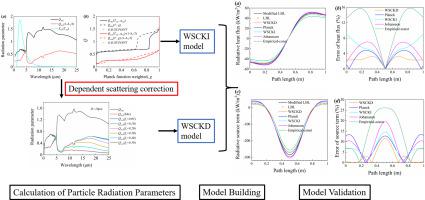Powder Technology ( IF 5.2 ) Pub Date : 2021-09-14 , DOI: 10.1016/j.powtec.2021.09.026 Zhen Cao 1 , Cai Liang 1 , Lunbo Duan 1 , Xiaoping Chen 1 , Daoyin Liu 1 , Jiliang Ma 1

|
The radiative heat transfer of the particles has been investigated based on the gray body and the independent scattering. However, the radiative properties of the particles are strongly wavelength dependent and interact with each other with the increase of particle concentration. In order to indicate the radiative heat transfer under the high particle volume fraction, the radiation heat transfer model of non-gray particle is developed in this paper, which is based on the ideology of the weighted sum of gray gases (WSGG) model and the full-spectrum correlated k-distribution (FSCK) model, and the dependent scattering of particles is considered. For a one-dimensional plane-parallel slab system, the WSCK (the Weighted Sum of Gray Particles based on the full-Spectrum Correlated k-distribution) model is verified. Compared with the modified LBL model based on Mie theory and dependent scattering theory, the maximum errors of the dependent scattering WSCK (WSCKD) model are about 3.3% for the radiative heat flux and 11.5% for the radiative source term under non-isothermal and inhomogeneous conditions. The radiative heat flux and radiative source term by the WSCKD model and the independent scattering WSCK (WSCKI) model are almost identical for the low particle volume fraction and the calculation accuracy is higher by the WSCKD model on the industrial scale. For the high particle volume fraction, the WSCKD model is more accurate, especially for particle systems with a large percentage of small particles or a relatively high-volume fraction. In addition, the radiative heat transfers of gases, particles and gas-particle mixtures at different one-dimensional scales are examined, highlighting the crucial role of particle radiative property model in large furnaces.
中文翻译:

基于相关散射的非灰粒子辐射特性模型
基于灰体和独立散射研究了颗粒的辐射传热。然而,粒子的辐射特性强烈依赖于波长,并且随着粒子浓度的增加而相互作用。为了表示高粒子体积分数下的辐射传热,本文基于灰色气体加权和(WSGG)模型的思想,建立了非灰色粒子的辐射传热模型。全谱相关 k 分布 (FSCK) 模型,并考虑了粒子的相关散射。对于一维平面平行板系统,验证了WSCK(基于全谱相关k分布的灰色粒子加权和)模型。与基于 Mie 理论和依赖散射理论的修正 LBL 模型相比,非等温和非均匀条件下,依赖散射 WSCK (WSCKD) 模型的最大误差对于辐射热通量约为 3.3%,对于辐射源项约为 11.5%状况。WSCKD模型和独立散射WSCK(WSCKI)模型的辐射热通量和辐射源项对于低粒子体积分数几乎相同,并且WSCKD模型在工业规模上的计算精度更高。对于高颗粒体积分数,WSCKD模型更准确,特别是对于小颗粒比例较大或体积分数相对较高的颗粒系统。此外,气体的辐射传热,


























 京公网安备 11010802027423号
京公网安备 11010802027423号